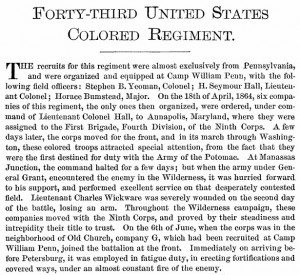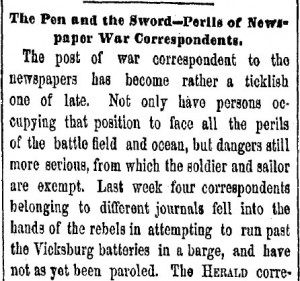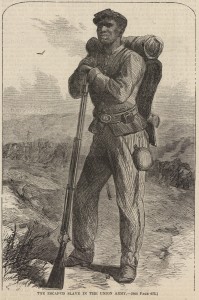
After being assembled at Camp William Penn, the 43rd USCT Regiment, composed mainly of Pennsylvania recruits, was assigned in April 1864 to the Ninth Corps of the Army of the Potomac. Continuing on through Washington, where the African-American regiment “attracted special attention,” the regiment became involved in the Wilderness Campaign in rural Virginia. On July 30, 1864, at the Battle of the Crater during the Siege of Petersburg, the regiment stepped in after the confusion of the explosion caused the division leading the charge to take cover:
- “The consternation created by the horrors of the explosion, enabled Ledlie’s Division to advance to, and take shelter in, the crater without serious loss… Finally when the enemy had fully recovered from his fright, had brought supports to cover the threatened point, and was fully prepared to repel further assaults, the Colored Division was ordered to advance. It was a forlorn hope; but the division moved gallantly forward, in the face of a decimating fire, and passing to the right of the crater, charged towards the crest beyond. Here so deadly was the fire of infantry and artillery which it met, that it was soon swept back in disorder amongst the debris of the demolished fort, though it succeeded in bringing in some prisoners, Captain Albert D. Wright taking, with his own hands, a rebel battle flag. Little protection was afforded even here, the enemy soon getting the range, and mercilessly slaughtering the helpless victims huddled together. A charge made upon them by the enemy, was bloodily repulsed; but it was madness to attempt to hold the position, and almost certain destruction to attempt to go back, every inch of the ground being raked by the enemy’s concentric fire.”
The regiment remained around Petersburg, doing fatigue duty and also fighting in the Battle of Hatcher’s Run in October 1864. Later, the War Department reassigned the regiment, and it was employed on the front lines in active duty around Richmond (especially at Dutch Gap Canal) until the fall of the Confederate capital. The full summary of the 43rd USCT Regiment’s actions during the Civil War as well as the complete muster roll is available through Google Books in volume five of Samuel P. Bates, History of Pennsylvania Volunteers, 1861-5 (1871).
 Correspondents from the New York Herald and other newspapers faced numerous problems in reporting during the Civil War. While “General Grant [was] not afraid of newspaper criticism,” the New York Herald described that others “generals exhibit[ed]…excessive sensitiveness to criticism.” These generals put in place “stringent measures” against newspapers and in some cases even arrested reporters. As the New York Herald explained:
Correspondents from the New York Herald and other newspapers faced numerous problems in reporting during the Civil War. While “General Grant [was] not afraid of newspaper criticism,” the New York Herald described that others “generals exhibit[ed]…excessive sensitiveness to criticism.” These generals put in place “stringent measures” against newspapers and in some cases even arrested reporters. As the New York Herald explained:


















